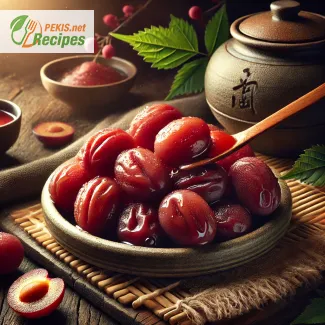
Discovering Umeboshi Plums: A Unique Japanese Superfood
Introduction to Umeboshi Plums
Umeboshi plums are a traditional Japanese delicacy, well-known for their intense sourness and saltiness. These preserved plums, often referred to as Japanese pickled plums, have been a staple in Japanese cuisine for centuries. Rich in nutrients, antioxidants, and probiotics, umeboshi are not only a flavorful addition to meals but also boast numerous health benefits.
Umeboshi are made from the ume fruit (Prunus mume), which is technically closer to an apricot than a plum. The fruit is harvested before ripening, then preserved in salt and sometimes combined with shiso leaves for additional flavor and color. Over time, the plums undergo a fermentation process, which enhances their digestive and health-promoting properties.
In this article, we will explore everything about umeboshi, from its history, nutritional value, health benefits, and traditional uses to how you can incorporate it into modern diets.
History and Cultural Significance of Umeboshi
Ancient Origins
The consumption of umeboshi dates back over a thousand years in Japan and China. In ancient Japan, samurai warriors used umeboshi as a natural energy booster and remedy for fatigue. It was believed that these plums could help soldiers recover from exhaustion and prevent illness, making them a vital part of the warrior's diet.
Umeboshi also played a role in traditional Japanese medicine. It was used as a cure for various ailments, including indigestion, food poisoning, and fatigue. The powerful alkalizing effect of umeboshi was particularly valued for maintaining balance in the body's pH levels.
Umeboshi in Japanese Cuisine
Today, umeboshi remains a key ingredient in Japanese culinary traditions. It is commonly enjoyed as a side dish, incorporated into rice balls (onigiri), or mixed into porridge and teas. Umeboshi paste is also used as a seasoning, adding a tangy and salty kick to sauces and dressings.
Nutritional Profile of Umeboshi
Umeboshi plums are small but packed with nutrients. They provide a rich source of essential vitamins and minerals, making them a beneficial addition to any diet.
Key Nutrients in Umeboshi:
- Vitamin C – Boosts immunity and supports skin health.
- Iron – Essential for oxygen transport and energy production.
- Calcium – Strengthens bones and teeth.
- Potassium – Helps regulate blood pressure and hydration levels.
- Fiber – Aids digestion and supports gut health.
Additionally, umeboshi plums contain organic acids such as citric acid and malic acid, which contribute to their distinctive sour taste and aid in detoxification and digestion.
Health Benefits of Umeboshi
1. Supports Digestive Health
Umeboshi contains natural probiotics and enzymes that promote a healthy gut microbiome. The fermentation process enhances beneficial bacteria, which can improve digestion, prevent bloating, and relieve constipation.
2. Strengthens the Immune System
The high vitamin C content in umeboshi plums helps boost immunity, making the body more resistant to infections. Their antimicrobial properties also help fight off harmful bacteria.
3. Detoxifies the Body
Umeboshi is known for its alkalizing effect, which helps neutralize acidic toxins in the body. It is often used as a natural remedy for hangovers, as it helps cleanse the liver and restore electrolyte balance.
4. Aids in Weight Management
Due to its high fiber content and ability to curb cravings, umeboshi can support weight loss efforts. The tangy and salty taste satisfies cravings while keeping calorie intake low.
5. Improves Energy and Reduces Fatigue
In traditional medicine, umeboshi is regarded as a natural energizer. The presence of iron and citric acid enhances the body's ability to produce energy and reduces feelings of fatigue.
6. Supports Heart Health
With its potassium-rich content, umeboshi helps regulate blood pressure and maintain heart health. It also aids in preventing hypertension and cardiovascular diseases.
How to Use Umeboshi in Your Diet
Umeboshi can be enjoyed in various ways, depending on personal taste and dietary preferences. Here are some common ways to incorporate it into your meals:
1. Traditional Japanese Dishes
- Onigiri (Rice Balls) – Umeboshi is placed in the center of a rice ball, wrapped with nori seaweed.
- Ochazuke (Tea-Soaked Rice) – A comforting dish where hot green tea is poured over rice with umeboshi.
- Miso Soup – Umeboshi adds a tangy depth to miso-based soups.
2. Umeboshi Paste as a Seasoning
- Salad Dressings – Blend umeboshi paste with olive oil, vinegar, and honey for a unique dressing.
- Sauces & Marinades – Use umeboshi to add depth of flavor to tofu, meat, and vegetable dishes.
- Dipping Sauce – Mix with soy sauce and sesame oil for a tangy dipping sauce.
3. Beverages and Home Remedies
- Umeboshi Tea (Ume-cha) – A warming drink made by dissolving a pickled plum in hot water.
- Hangover Cure – Drinking umeboshi-infused water helps replenish electrolytes and detoxify the liver.
4. Modern Applications
- Smoothies – Adds a tangy twist to fruit-based smoothies.
- Vegan Sushi – Used as a filling for plant-based sushi rolls.
- Fermented Foods – Combined with other fermented vegetables for gut health benefits.
How to Store and Preserve Umeboshi
Umeboshi has a long shelf life due to its high salt content. Here are some tips on how to store it properly:
- In Brine – Keep umeboshi submerged in its original brine for preservation.
- Airtight Container – Store dried umeboshi in an airtight jar in a cool, dry place.
- Refrigeration – For umeboshi paste, keep it refrigerated to maintain freshness.
Why You Should Try Umeboshi
Umeboshi plums are more than just a Japanese culinary tradition – they are a superfood packed with health benefits. Whether you enjoy them in traditional Japanese dishes, as a seasoning, or as a natural remedy, umeboshi provides a unique taste and powerful nutrients to support overall well-being.
By incorporating umeboshi into your diet, you can enjoy its digestive, immune-boosting, and detoxifying properties, all while savoring its distinctive salty-sour flavor.
Have you tried umeboshi before? Share your favorite ways to enjoy it in the comments below!